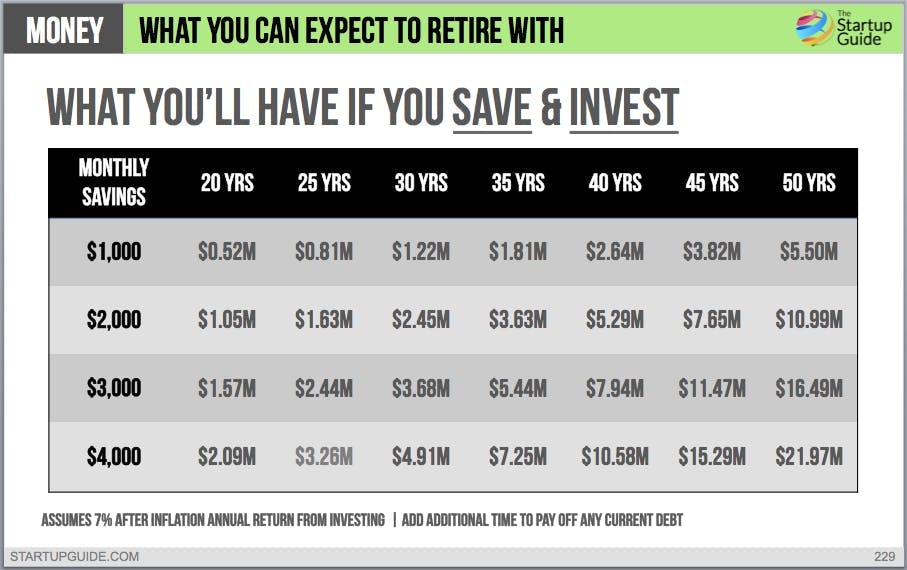Strategies for financial security: How to invest money
fter spending years effectively saving your money, the time is nigh to invest it properly. But where? We take a look at three possible investment options available to help your finances flourish.
This article was written by the original owner of startupguide.com, Ryan Allis, and published on his website in 2012. Read more about why Ryan was happy to hand over his website domain to us here.
Debt investments and equity
Let’s talk about investing wisely. There are really two types of investments: debt and equity.
Debt investments are loans. You earn a fixed interest rate every period (say, every year). You might be able to give a loan to a neighbor and get a 10 percent annual return. You might be able to invest in something like a lending club and distribute your loans across hundreds of people and get a diversified return.
Whether it be a treasury bond, a savings account, a loan to a friend, or a loan through Lending Club or Prosper, debt investments are loans with a fixed principle and a fixed interest rate return.
Equity is different than debt because equity involves the investment of money in exchange for partial ownership in a venture: a company. Equity investing is simply purchasing equity, which is another name for stock or ownership in a for-profit business.
With equity, you don’t get a payment except when the company distributes profits, which are called dividends. You get most of your return when the value of the company goes up, (in other words, when the market values the company more), because the level of that company’s profits or expected future profits has risen.
There are many things in the market that can make the value of a company go up, but generally it happens when the present value of its future expected cash flow is higher. Present value just means the expectation of the future, discounted to today.
There are dozens of different types of debt and dozens of different types of equity. Savings accounts, treasury bonds, muni bonds, corporate bonds, and peer-to-peer lending are all forms of debt. Mutual funds, index funds, exchange traded funds, emerging market investments, private companies, venture funds, hedge funds, options (rights to buy in the future or ways to sell in the future with put options) are all types of equity.
As we talk more about debt and equity - particularly equity, where the return is often variable - it’s important to know that there’s a correlation between return, (the amount of money you make back during a period of time; for example, if I have $1,000 on January 1st and I have $1,100 on December 31st, then I’ve earned a 10 percent return on my money that year), and volatility, (the fluctuation in price).
A lot of people choose not to invest in the stock market because they think it’s a gambling game of speculation. The reality is that the stock market is simply a place that enables people to buy and sell ownership interest in companies. One of the greatest wealth-producing vehicles of all time is ownership interest in businesses.
Let’s take a closer look at the average annual returns by type of investment, including both common debt instruments and common equity investments.

Graphic: Ryan Allis
You can see, for example, that the Dow Jones Industrial Index Average over the course of 50 or 60 years generally falls between 9-11 percent, whereas savings accounts are often less than 0.5 percent. Even the best banks will only give you 1 percent on your money back each year.
After inflation, many of the debt instruments have a negative return. With savings accounts, certificates of deposit, and treasury bonds, you might think you’re making money on your money, but you’re actually losing it. That’s not worth the risk. As I said before, the riskiest thing you can do is have a guaranteed negative return every year.
What’s less risky is investing in things that have a positive after-inflation return. Muni bonds, corporate bonds, and lending club notes, for example, enable you to take some risk, but on average have a positive after-inflation return, which, over the long-term, may give you a better return overall.
Equities, which are the S&P 500 Index and the Dow Jones Index Fund, often have some of the best rates of annual return over the long-term, but are the most volatile, which means they fluctuate the most year to year. Many of us have not-so-fond memories of 2008, when the stock market dropped quite significantly. Fewer of us alive today remember 1929, the other time when the stock market in the US dropped dramatically.
Whether it was 1932, 2001, 1987 or 2008, there are many times when the stock market has dropped more than 25 percent in a year. But on average, even including all of those metrics, we still see double-digit returns before adjusting for inflation.
Peer-to-peer lending
One of the investment areas I’ve found to be most exciting recently is peer-to-peer lending.
Lending Club and Prosper are the two leaders in this market. Peer-to-peer lending means that you as an investor, an individual with savings, can invest in a number of loans that are given to other people who are seeking loans in order to pay off and consolidate debt, go to school, travel, or have a wedding.
Often, the interest rate on these loans will range from 6 percent at the low end to 24 percent at the high end. Even after default, organizations like Lending Club are able to provide, (at least for the time being), a very attractive return.
I started investing with Lending Club in 2012 and I’m seeing interestingly positive results so far. One of the ways that they enable you to have lower risk yet get a pretty good return even with a debt or loan type investment is by diversifying the money you’re lending, $25 at a time, into hundreds of different loans.
For example, if you make a $2,500 investment in Lending Club, you can select 100 loans for it to be divided between, so if one loan defaults, you’ll only be losing 1 percent of your principal.
Lending Club enables you to select loans to be provided from you to the recipient based on many risk factors—demographics, states, credit score, history, how much credit they have outstanding already. It enables you to very clearly narrow down options as you choose.
They also give letter grades to each of the recipients of loans ranging from A to F. What I found personally is the A, B, and C loans are the safest, but they also have the lowest return. What you want to look at is the combination of safety and return averaged out across multiple loans. At least according to the data that Lending Club publishes, investors that invest across hundreds of loans ($25 per loan), are able to get higher after-default returns from the D, E, and F lending notes that they provide.
Of course, past performance is by no means a perfect predictor of future performance. However, I would encourage you to consider peer-to-peer lending organizations like Lending Club and Prosper as part of your investment mix.
These investments can still be risky, but if you look at the data, at least for the time being, they are providing one of the lowest risk ways, (on a risk-adjusted return basis), to generate double-digit returns on your money.
Angel investing
Angel investing has become all the rage in San Francisco and Silicon Valley and involves purchasing ownership in an early stage private company.
Today, for companies that not only have no profits, but no revenue (in other words, they have an infinite price-to-earnings ratio and an infinite revenue multiple), we’re seeing valuations starting at $5 million for a company that might only be a couple of months old.
Illustrating this phenomenon in 2012 was the $700 million acquisition of Instagram, (a company with 13 employees, no revenue, and no profits), by Facebook. Now, that’s a rare example, an edge case.
Oftentimes it could take decades to build a company to be worth $700 million. But the people who invested early in Instagram and other companies that have done very well in the innovation capital of the world have enabled an ecosystem that creates more and more demand for early stage high technology and deep scientific companies, that are working hard to make a positive impact on the world.
To sum it all up
To summarize the last three articles, you can become wealthy over time by paying off your debt, by saving, by using the results from your savings to invest, by using the proceeds from that investing to invest more, and by not going into debt for things that you really don’t need.
There are two different types of people in this world: people who pay interest on loans and work for companies, and people who receive interest on loans and own parts of companies.
The really important question is: which segment are you in? If you’re in the first right now, think about how you can shift in the next five or ten years.
How can you go from paying interest on your debt and working for companies, to receiving interest on loans that you make and owning parts of companies that produce cash flow for you and your family?
This is the third in a series of three articles which provide a roadmap to becoming a millionaire during your lifetime either by building a business of your own or by consistently saving and investing $1,000 each month for 30 years.
Main photo: Unsplash
*This article was originally published on October 17th, 2018 and updated on December 11th, 2018.

